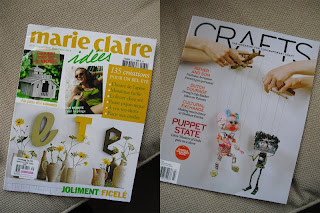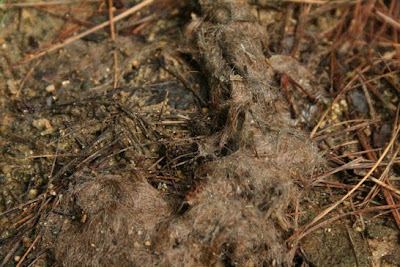Look what just arrived on my doormat this morning. Will settle down to these later!

 I like the rim light and the form of the statue - it's quite an iconic silhouette. But the background is undoubtedly a bit too cluttered. I couldn't get any closer or lower to take the photo, as the area was cordoned off and a policewoman standing there! (All to do with the Tall Ships Race a couple of years back). So...what to do?
I like the rim light and the form of the statue - it's quite an iconic silhouette. But the background is undoubtedly a bit too cluttered. I couldn't get any closer or lower to take the photo, as the area was cordoned off and a policewoman standing there! (All to do with the Tall Ships Race a couple of years back). So...what to do? In order to blend the two images together I had to lift the silhouette off its background and place it on the 'new' sunset sky. Easier said than done, to make it look realistic! You need a very precise selection around the part of the image you want to move.
In order to blend the two images together I had to lift the silhouette off its background and place it on the 'new' sunset sky. Easier said than done, to make it look realistic! You need a very precise selection around the part of the image you want to move. The finished picture may not look wholly realistic, but it gives the silhouette more impact, I think.
The finished picture may not look wholly realistic, but it gives the silhouette more impact, I think.  Decay doesn't have to take 100 years, sometimes just in your own life span humans can build things, and watch their tiny personal empire fall to pieces. There's always a hidden story, a mini drama, a loss, forgotten time or sometimes a death these places hold onto... but for the blue shack not very much longer.
Decay doesn't have to take 100 years, sometimes just in your own life span humans can build things, and watch their tiny personal empire fall to pieces. There's always a hidden story, a mini drama, a loss, forgotten time or sometimes a death these places hold onto... but for the blue shack not very much longer. The house is caving in. Literally. Porch posts leaning into a V shape, if you step on the covered porch floor boards your foot will go through it. Windows are broken, wood is bending, pieces of the roof are falling off.... yet it still holds it's bright blue spirit, you can still read some of the dreams that were afloat when it was built.
The house is caving in. Literally. Porch posts leaning into a V shape, if you step on the covered porch floor boards your foot will go through it. Windows are broken, wood is bending, pieces of the roof are falling off.... yet it still holds it's bright blue spirit, you can still read some of the dreams that were afloat when it was built. The back of the house pushes up to a rather steep hill, which is probably why the blue paint has washed off, the wall is pushing outward under the weight of the roof.... even a piece of the whole back wall has opened up and a freakin' lawn chair is poking out! Somehow that is creepy.
The back of the house pushes up to a rather steep hill, which is probably why the blue paint has washed off, the wall is pushing outward under the weight of the roof.... even a piece of the whole back wall has opened up and a freakin' lawn chair is poking out! Somehow that is creepy. Peeking into the windows, I didn't find much on the inside of the house --- the usual anticipation to see something beautiful in it's last run of decay was not really even there...
Peeking into the windows, I didn't find much on the inside of the house --- the usual anticipation to see something beautiful in it's last run of decay was not really even there... Unless you feel a toilet seat is beautiful....
Unless you feel a toilet seat is beautiful.... The ceiling is peeling off in sheets, which shows the rafters.... the rafters are the only thing about the structure that still looks stable. "Stable" being used real loosely.
The ceiling is peeling off in sheets, which shows the rafters.... the rafters are the only thing about the structure that still looks stable. "Stable" being used real loosely. Since there was 13 more acres of mystery to explore, I set off up the long winding road that led back up the side of the mountain. Plants & wildlife abound...
Since there was 13 more acres of mystery to explore, I set off up the long winding road that led back up the side of the mountain. Plants & wildlife abound... Raspberries!!! Mmmmmm - the berries will pop out those hairy shells....
Raspberries!!! Mmmmmm - the berries will pop out those hairy shells.... Blackberries ..... about to be ripe!
Blackberries ..... about to be ripe! Woodland Nettles and Jewelweed growing in patches together.... ( so if the nettles sting you, you can put the jewelweed on your skin to sooth it!)
Woodland Nettles and Jewelweed growing in patches together.... ( so if the nettles sting you, you can put the jewelweed on your skin to sooth it!) There was also a small hidden barn, with wide open slats --- it was totally covered in thorny wild roses making it impossible for me to go inside or get near it!
There was also a small hidden barn, with wide open slats --- it was totally covered in thorny wild roses making it impossible for me to go inside or get near it! Then a fresh deer track in the mud, it slid a little downward because of the steep part of the path...
Then a fresh deer track in the mud, it slid a little downward because of the steep part of the path... right next to the deer track was a patch of jewelweed (see the pic below) that the tops of the plants were eaten off....
right next to the deer track was a patch of jewelweed (see the pic below) that the tops of the plants were eaten off.... On my way back down I stopped to take a pic with the rocks being exposed from the erosion along the road... I LOVE big funky rocks! ANd I loooooove (not) trespassing. :)
On my way back down I stopped to take a pic with the rocks being exposed from the erosion along the road... I LOVE big funky rocks! ANd I loooooove (not) trespassing. :)

 "If the true meaning of sustainability involves giving back more than what you take from the land, then nothing that takes more from the land than it returns can define itself as sustainable. Less destructive does not mean more sustainable." - Rewild Or Die
"If the true meaning of sustainability involves giving back more than what you take from the land, then nothing that takes more from the land than it returns can define itself as sustainable. Less destructive does not mean more sustainable." - Rewild Or Die Ya'll know how I love to read, and over the last year I had mostly immersed myself in fiction books - as a direct retaliation to reading years of health, self help and spiritual books.
Ya'll know how I love to read, and over the last year I had mostly immersed myself in fiction books - as a direct retaliation to reading years of health, self help and spiritual books. I had heard about the Hemlock Pine trees in the mountains here dying out a few years ago, but had never really seen the damage, the reality of what was happening till moving here to Hot Springs, NC. Here at the Luck Cabin (and throughout the adjacent forest) there are scores of big HUGE old growth Hemlocks, and many smaller ones too - all dead or near death, falling down to the ground in piles, families of barren trunks, groves of up-turned roots.
I had heard about the Hemlock Pine trees in the mountains here dying out a few years ago, but had never really seen the damage, the reality of what was happening till moving here to Hot Springs, NC. Here at the Luck Cabin (and throughout the adjacent forest) there are scores of big HUGE old growth Hemlocks, and many smaller ones too - all dead or near death, falling down to the ground in piles, families of barren trunks, groves of up-turned roots. I was told by an Old Timer neighbor that when the bark starts pealing off and shows this red color pictured here, it means it will soon fall to the ground. Another neighbor said after it's death, due to shallow roots, they will fall over within one year of dying.
I was told by an Old Timer neighbor that when the bark starts pealing off and shows this red color pictured here, it means it will soon fall to the ground. Another neighbor said after it's death, due to shallow roots, they will fall over within one year of dying. 
 Under these giant dead trees are the young new sprouts, of tiny hemlocks - ones that looks free of the disease. One thing about the forest is it knows how to renew itself... the sucky thing is, we have yet to begin to understand what the impact of losing old growth trees has on the eco system. There may be some lag time between now and like, say 200 years from now when these can right themselves again. Then again, before recorded history I have to wonder how many times species were wiped out and no one would ever know about it now... if these things are part of natural life cycles, we call disasters?
Under these giant dead trees are the young new sprouts, of tiny hemlocks - ones that looks free of the disease. One thing about the forest is it knows how to renew itself... the sucky thing is, we have yet to begin to understand what the impact of losing old growth trees has on the eco system. There may be some lag time between now and like, say 200 years from now when these can right themselves again. Then again, before recorded history I have to wonder how many times species were wiped out and no one would ever know about it now... if these things are part of natural life cycles, we call disasters?